Zheng Zhan
Decoder-Hybrid-Decoder Architecture for Efficient Reasoning with Long Generation
Jul 09, 2025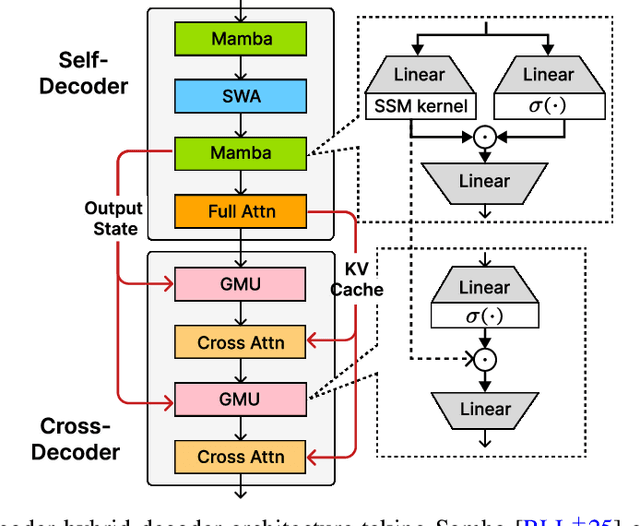

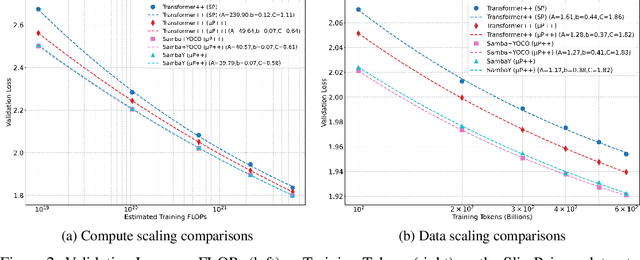

Abstract:Recent advances in language modeling have demonstrated the effectiveness of State Space Models (SSMs) for efficient sequence modeling. While hybrid architectures such as Samba and the decoder-decoder architecture, YOCO, have shown promising performance gains over Transformers, prior works have not investigated the efficiency potential of representation sharing between SSM layers. In this paper, we introduce the Gated Memory Unit (GMU), a simple yet effective mechanism for efficient memory sharing across layers. We apply it to create SambaY, a decoder-hybrid-decoder architecture that incorporates GMUs in the cross-decoder to share memory readout states from a Samba-based self-decoder. SambaY significantly enhances decoding efficiency, preserves linear pre-filling time complexity, and boosts long-context performance, all while eliminating the need for explicit positional encoding. Through extensive scaling experiments, we demonstrate that our model exhibits a significantly lower irreducible loss compared to a strong YOCO baseline, indicating superior performance scalability under large-scale compute regimes. Our largest model enhanced with Differential Attention, Phi4-mini-Flash-Reasoning, achieves significantly better performance than Phi4-mini-Reasoning on reasoning tasks such as Math500, AIME24/25, and GPQA Diamond without any reinforcement learning, while delivering up to 10x higher decoding throughput on 2K-length prompts with 32K generation length under the vLLM inference framework. We release our training codebase on open-source data at https://github.com/microsoft/ArchScale.
Enabling Flexible Multi-LLM Integration for Scalable Knowledge Aggregation
May 28, 2025



Abstract:Large language models (LLMs) have shown remarkable promise but remain challenging to continually improve through traditional finetuning, particularly when integrating capabilities from other specialized LLMs. Popular methods like ensemble and weight merging require substantial memory and struggle to adapt to changing data environments. Recent efforts have transferred knowledge from multiple LLMs into a single target model; however, they suffer from interference and degraded performance among tasks, largely due to limited flexibility in candidate selection and training pipelines. To address these issues, we propose a framework that adaptively selects and aggregates knowledge from diverse LLMs to build a single, stronger model, avoiding the high memory overhead of ensemble and inflexible weight merging. Specifically, we design an adaptive selection network that identifies the most relevant source LLMs based on their scores, thereby reducing knowledge interference. We further propose a dynamic weighted fusion strategy that accounts for the inherent strengths of candidate LLMs, along with a feedback-driven loss function that prevents the selector from converging on a single subset of sources. Experimental results demonstrate that our method can enable a more stable and scalable knowledge aggregation process while reducing knowledge interference by up to 50% compared to existing approaches. Code is avaliable at https://github.com/ZLKong/LLM_Integration
Perturbation-efficient Zeroth-order Optimization for Hardware-friendly On-device Training
Apr 28, 2025Abstract:Zeroth-order (ZO) optimization is an emerging deep neural network (DNN) training paradigm that offers computational simplicity and memory savings. However, this seemingly promising approach faces a significant and long-ignored challenge. ZO requires generating a substantial number of Gaussian random numbers, which poses significant difficulties and even makes it infeasible for hardware platforms, such as FPGAs and ASICs. In this paper, we identify this critical issue, which arises from the mismatch between algorithm and hardware designers. To address this issue, we proposed PeZO, a perturbation-efficient ZO framework. Specifically, we design random number reuse strategies to significantly reduce the demand for random number generation and introduce a hardware-friendly adaptive scaling method to replace the costly Gaussian distribution with a uniform distribution. Our experiments show that PeZO reduces the required LUTs and FFs for random number generation by 48.6\% and 12.7\%, and saves at maximum 86\% power consumption, all without compromising training performance, making ZO optimization feasible for on-device training. To the best of our knowledge, we are the first to explore the potential of on-device ZO optimization, providing valuable insights for future research.
Harmony in Divergence: Towards Fast, Accurate, and Memory-efficient Zeroth-order LLM Fine-tuning
Feb 05, 2025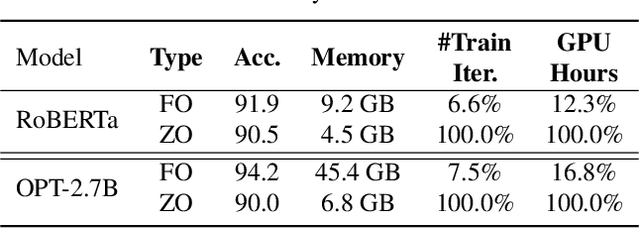
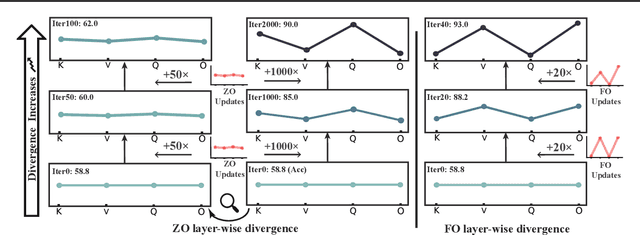

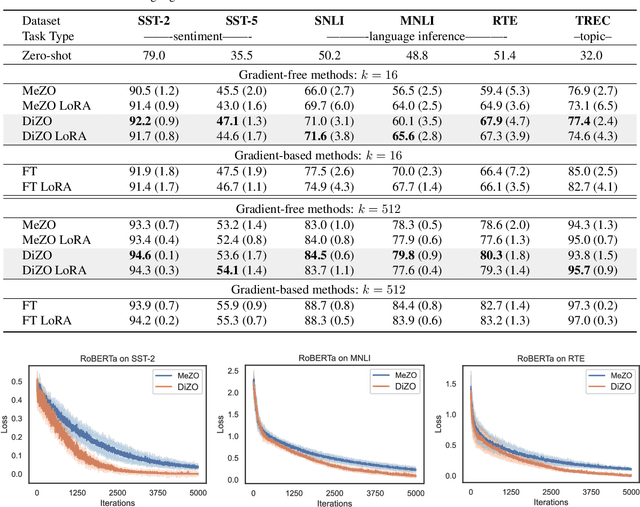
Abstract:Large language models (LLMs) excel across various tasks, but standard first-order (FO) fine-tuning demands considerable memory, significantly limiting real-world deployment. Recently, zeroth-order (ZO) optimization stood out as a promising memory-efficient training paradigm, avoiding backward passes and relying solely on forward passes for gradient estimation, making it attractive for resource-constrained scenarios. However, ZO method lags far behind FO method in both convergence speed and accuracy. To bridge the gap, we introduce a novel layer-wise divergence analysis that uncovers the distinct update pattern of FO and ZO optimization. Aiming to resemble the learning capacity of FO method from the findings, we propose \textbf{Di}vergence-driven \textbf{Z}eroth-\textbf{O}rder (\textbf{DiZO}) optimization. DiZO conducts divergence-driven layer adaptation by incorporating projections to ZO updates, generating diverse-magnitude updates precisely scaled to layer-wise individual optimization needs. Our results demonstrate that DiZO significantly reduces the needed iterations for convergence without sacrificing throughput, cutting training GPU hours by up to 48\% on various datasets. Moreover, DiZO consistently outperforms the representative ZO baselines in fine-tuning RoBERTa-large, OPT-series, and Llama-series on downstream tasks and, in some cases, even surpasses memory-intensive FO fine-tuning.
Mojito: Motion Trajectory and Intensity Control for Video Generation
Dec 12, 2024



Abstract:Recent advancements in diffusion models have shown great promise in producing high-quality video content. However, efficiently training diffusion models capable of integrating directional guidance and controllable motion intensity remains a challenging and under-explored area. This paper introduces Mojito, a diffusion model that incorporates both \textbf{Mo}tion tra\textbf{j}ectory and \textbf{i}ntensi\textbf{t}y contr\textbf{o}l for text to video generation. Specifically, Mojito features a Directional Motion Control module that leverages cross-attention to efficiently direct the generated object's motion without additional training, alongside a Motion Intensity Modulator that uses optical flow maps generated from videos to guide varying levels of motion intensity. Extensive experiments demonstrate Mojito's effectiveness in achieving precise trajectory and intensity control with high computational efficiency, generating motion patterns that closely match specified directions and intensities, providing realistic dynamics that align well with natural motion in real-world scenarios.
Fast and Memory-Efficient Video Diffusion Using Streamlined Inference
Nov 02, 2024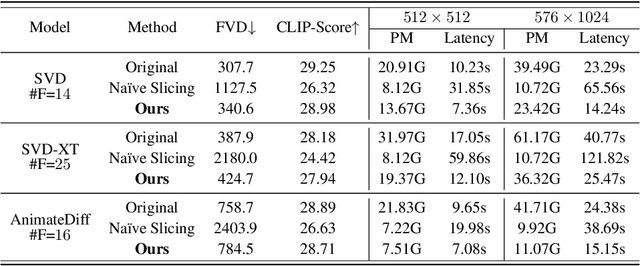
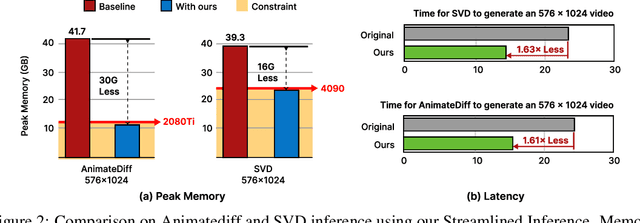

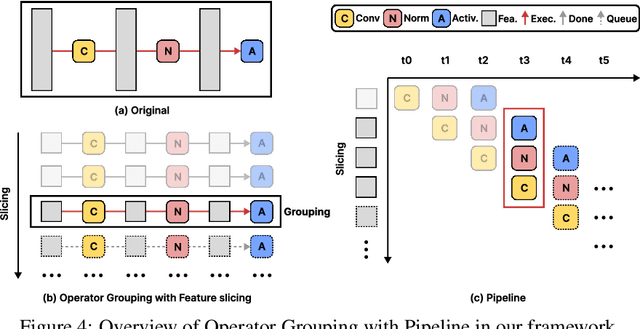
Abstract:The rapid progress in artificial intelligence-generated content (AIGC), especially with diffusion models, has significantly advanced development of high-quality video generation. However, current video diffusion models exhibit demanding computational requirements and high peak memory usage, especially for generating longer and higher-resolution videos. These limitations greatly hinder the practical application of video diffusion models on standard hardware platforms. To tackle this issue, we present a novel, training-free framework named Streamlined Inference, which leverages the temporal and spatial properties of video diffusion models. Our approach integrates three core components: Feature Slicer, Operator Grouping, and Step Rehash. Specifically, Feature Slicer effectively partitions input features into sub-features and Operator Grouping processes each sub-feature with a group of consecutive operators, resulting in significant memory reduction without sacrificing the quality or speed. Step Rehash further exploits the similarity between adjacent steps in diffusion, and accelerates inference through skipping unnecessary steps. Extensive experiments demonstrate that our approach significantly reduces peak memory and computational overhead, making it feasible to generate high-quality videos on a single consumer GPU (e.g., reducing peak memory of AnimateDiff from 42GB to 11GB, featuring faster inference on 2080Ti).
Rethinking Token Reduction for State Space Models
Oct 16, 2024



Abstract:Recent advancements in State Space Models (SSMs) have attracted significant interest, particularly in models optimized for parallel training and handling long-range dependencies. Architectures like Mamba have scaled to billions of parameters with selective SSM. To facilitate broader applications using Mamba, exploring its efficiency is crucial. While token reduction techniques offer a straightforward post-training strategy, we find that applying existing methods directly to SSMs leads to substantial performance drops. Through insightful analysis, we identify the reasons for this failure and the limitations of current techniques. In response, we propose a tailored, unified post-training token reduction method for SSMs. Our approach integrates token importance and similarity, thus taking advantage of both pruning and merging, to devise a fine-grained intra-layer token reduction strategy. Extensive experiments show that our method improves the average accuracy by 5.7% to 13.1% on six benchmarks with Mamba-2 compared to existing methods, while significantly reducing computational demands and memory requirements.
Exploring Token Pruning in Vision State Space Models
Sep 27, 2024



Abstract:State Space Models (SSMs) have the advantage of keeping linear computational complexity compared to attention modules in transformers, and have been applied to vision tasks as a new type of powerful vision foundation model. Inspired by the observations that the final prediction in vision transformers (ViTs) is only based on a subset of most informative tokens, we take the novel step of enhancing the efficiency of SSM-based vision models through token-based pruning. However, direct applications of existing token pruning techniques designed for ViTs fail to deliver good performance, even with extensive fine-tuning. To address this issue, we revisit the unique computational characteristics of SSMs and discover that naive application disrupts the sequential token positions. This insight motivates us to design a novel and general token pruning method specifically for SSM-based vision models. We first introduce a pruning-aware hidden state alignment method to stabilize the neighborhood of remaining tokens for performance enhancement. Besides, based on our detailed analysis, we propose a token importance evaluation method adapted for SSM models, to guide the token pruning. With efficient implementation and practical acceleration methods, our method brings actual speedup. Extensive experiments demonstrate that our approach can achieve significant computation reduction with minimal impact on performance across different tasks. Notably, we achieve 81.7\% accuracy on ImageNet with a 41.6\% reduction in the FLOPs for pruned PlainMamba-L3. Furthermore, our work provides deeper insights into understanding the behavior of SSM-based vision models for future research.
Search for Efficient Large Language Models
Sep 25, 2024


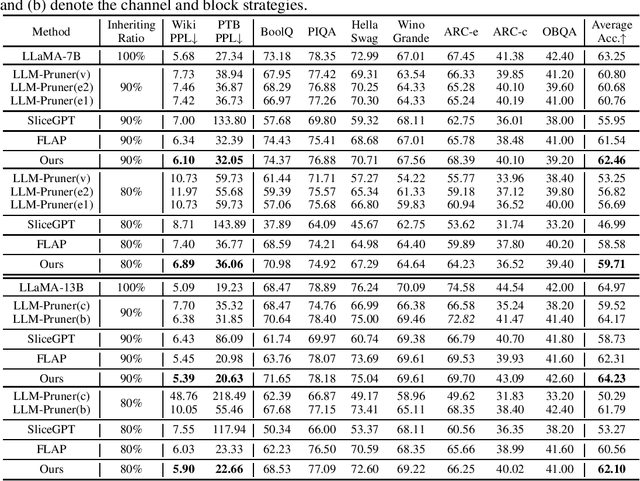
Abstract:Large Language Models (LLMs) have long held sway in the realms of artificial intelligence research. Numerous efficient techniques, including weight pruning, quantization, and distillation, have been embraced to compress LLMs, targeting memory reduction and inference acceleration, which underscore the redundancy in LLMs. However, most model compression techniques concentrate on weight optimization, overlooking the exploration of optimal architectures. Besides, traditional architecture search methods, limited by the elevated complexity with extensive parameters, struggle to demonstrate their effectiveness on LLMs. In this paper, we propose a training-free architecture search framework to identify optimal subnets that preserve the fundamental strengths of the original LLMs while achieving inference acceleration. Furthermore, after generating subnets that inherit specific weights from the original LLMs, we introduce a reformation algorithm that utilizes the omitted weights to rectify the inherited weights with a small amount of calibration data. Compared with SOTA training-free structured pruning works that can generate smaller networks, our method demonstrates superior performance across standard benchmarks. Furthermore, our generated subnets can directly reduce the usage of GPU memory and achieve inference acceleration.
Efficient Training with Denoised Neural Weights
Jul 16, 2024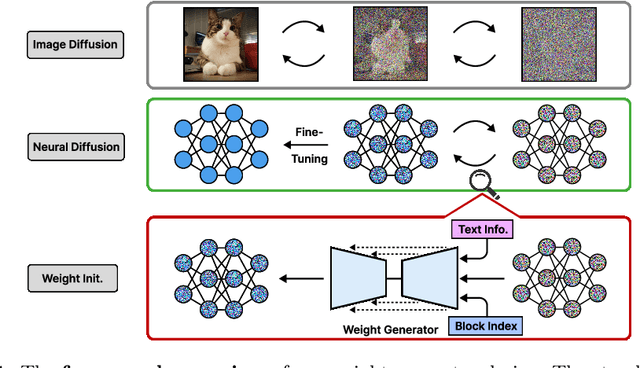
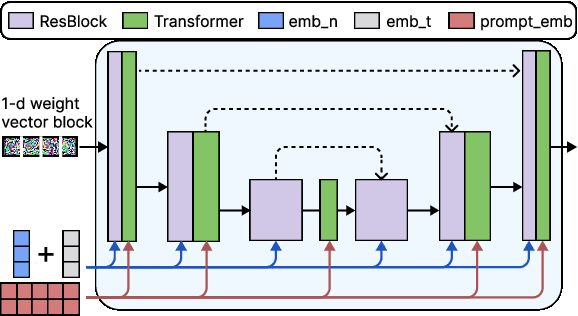
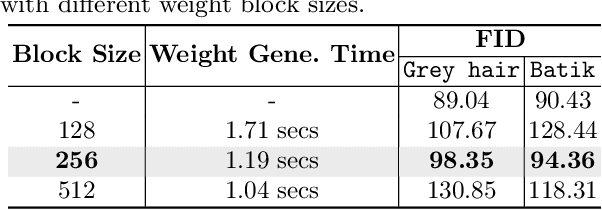
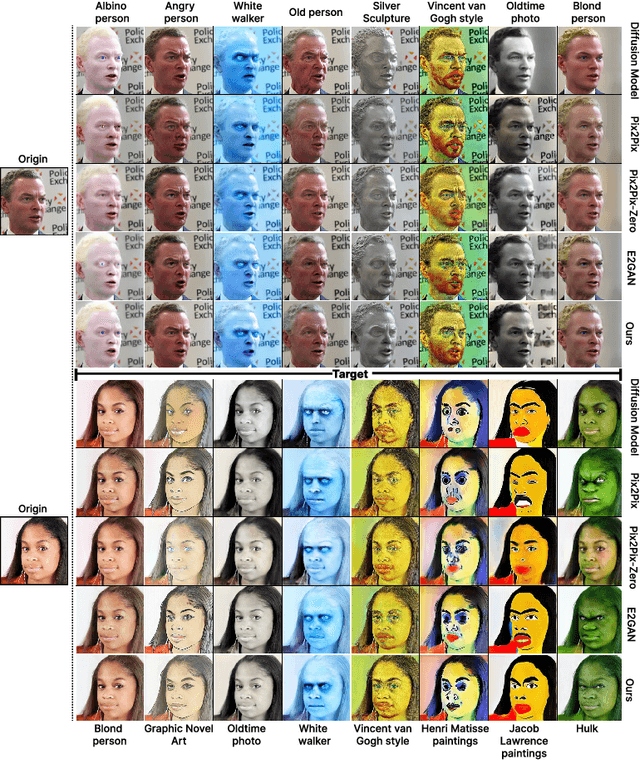
Abstract:Good weight initialization serves as an effective measure to reduce the training cost of a deep neural network (DNN) model. The choice of how to initialize parameters is challenging and may require manual tuning, which can be time-consuming and prone to human error. To overcome such limitations, this work takes a novel step towards building a weight generator to synthesize the neural weights for initialization. We use the image-to-image translation task with generative adversarial networks (GANs) as an example due to the ease of collecting model weights spanning a wide range. Specifically, we first collect a dataset with various image editing concepts and their corresponding trained weights, which are later used for the training of the weight generator. To address the different characteristics among layers and the substantial number of weights to be predicted, we divide the weights into equal-sized blocks and assign each block an index. Subsequently, a diffusion model is trained with such a dataset using both text conditions of the concept and the block indexes. By initializing the image translation model with the denoised weights predicted by our diffusion model, the training requires only 43.3 seconds. Compared to training from scratch (i.e., Pix2pix), we achieve a 15x training time acceleration for a new concept while obtaining even better image generation quality.
 Add to Chrome
Add to Chrome Add to Firefox
Add to Firefox Add to Edge
Add to Edge